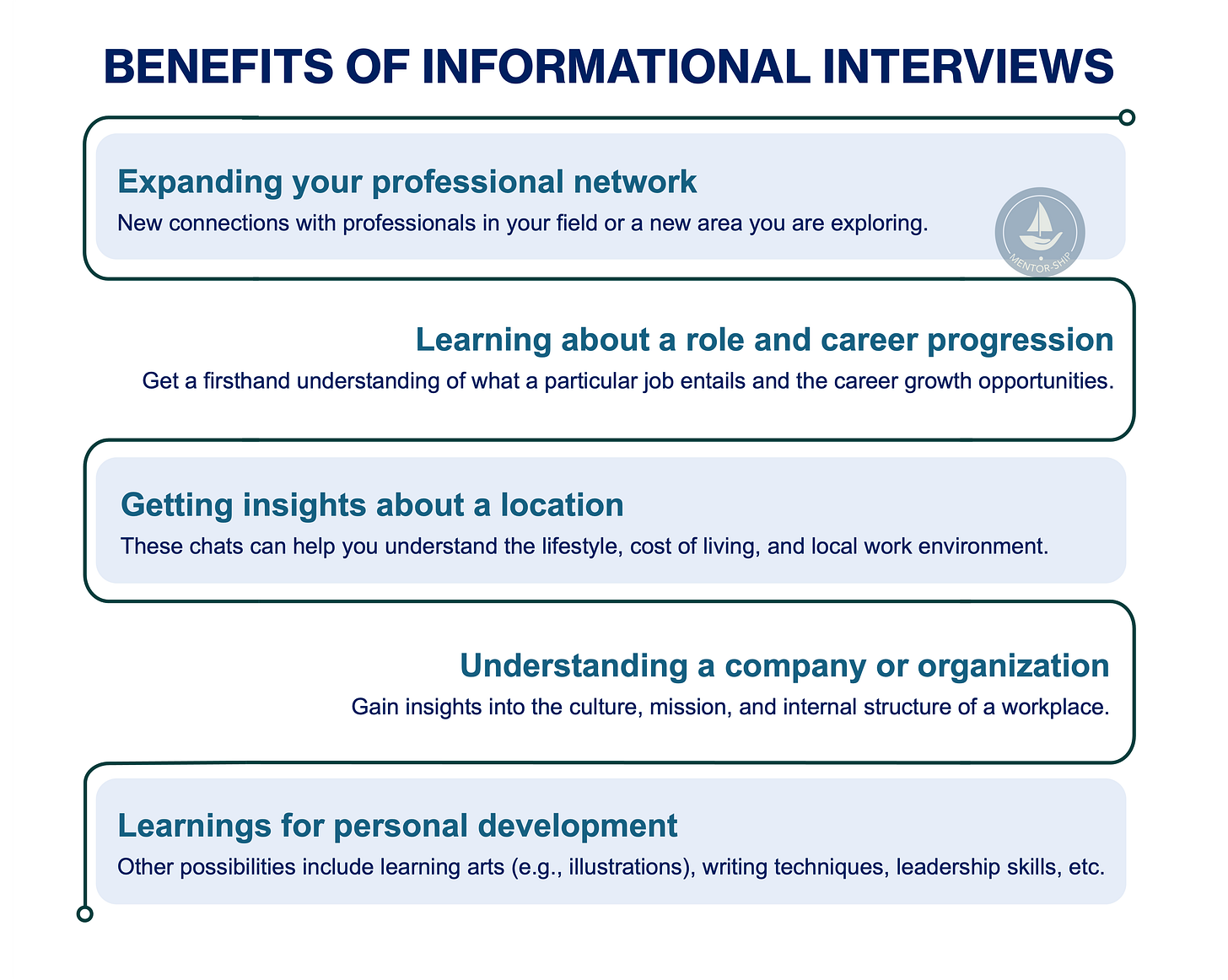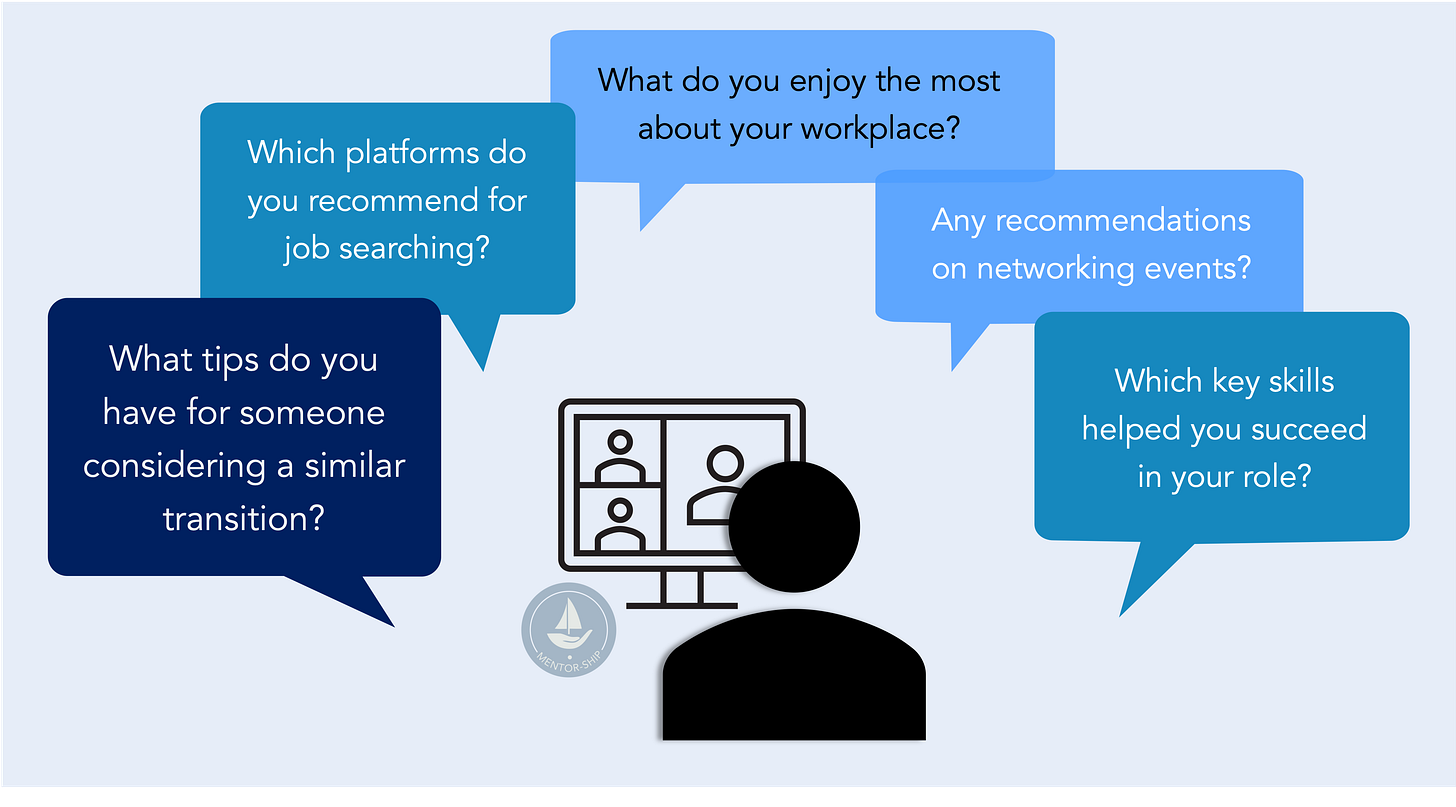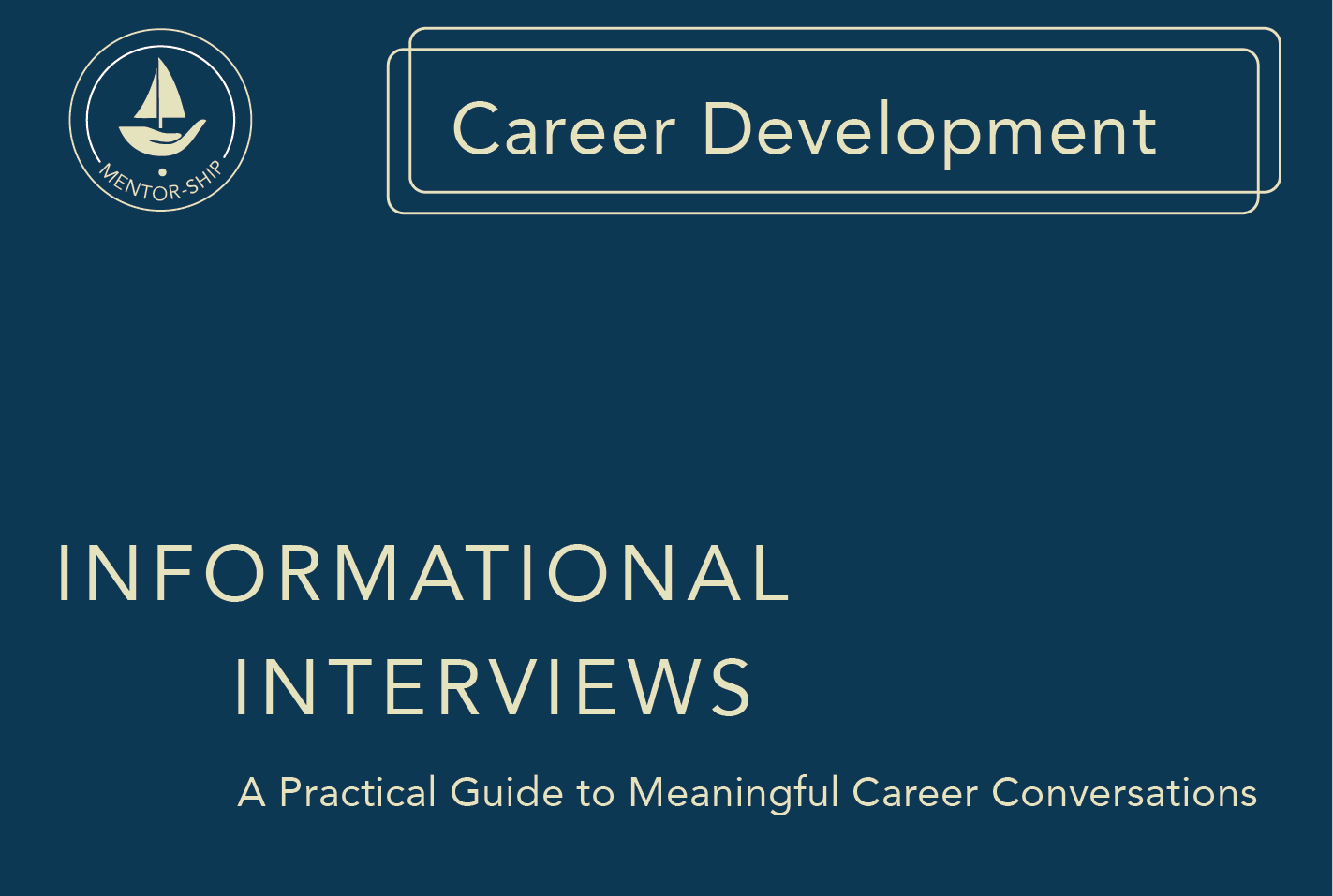The Power of Informational Interviews
Sailing into New Waters: A Practical Conversation Guide
Mentor-Ship is introducing the first article of our career development series focused on a powerful proactive learning tool for career exploration and networking: informational interviews.
In a previous post, we discussed a mentors role in recommending helpful tools and resources to support mentees in achieving their career goals. Just as important, mentees can also take the helm of their mentoring journey and either explore the shared tools and/or tap into resources available through their organization, like workshops, team building events, coffee chats, lunch and talks with speakers, etc. Resources can also be found online, including our Mentor-Ship initiative. Among other benefits, these promote skill-building, portfolio-building, and networking.
Personally, I first discovered informational interviews at a career event during my postdoc. I was instantly intrigued. I dove in, learned more about and gradually integrated them into my weekly routine, particularly during key moments of career transition. These conversations quickly became invaluable for growing my network, clarifying roles aligned with my goals (and, importantly, ruling out others), discovering new interests (i.e. books for my hobby in illustration), and connecting with professionals in my field, even in cities I considered relocating to.
Having experienced its benefits firsthand, I have recommended informational interviews not only to mentees but also to work colleagues. I am confident that this tool will prove helpful to you too. Below, I share a guide with a few tips and tricks to help you get comfortable with informational interviews.
We are each other’s harvest. We are each other’s business. We are each other’s magnitude and bond. (Claudia Rankine)
What are Informational Interviews?
Informational Interviews are short (around 30 minutes) meetings with someone working in a career, position, field and/or organization that you are particularly interested. Although informal, these conversations have a professional tone and should be treated accordingly. Think of them as a chance to “ask the pilot for their logbook” to understand their experiences or get advice on a specific sea. Importantly, these are not to be confused with the conventional job interview, and it should be used for building your network of contacts and navigating your career journey.

If you are just setting sail with informational interviews, I have logged my entries from 3 years of using this tool and compiled my own “captain’s log” below. Here is how I suggest navigating these valuable conversations:
Step 1: Approach and Connect with People
This is one of the most difficult steps as it makes one get away from their comfortable zone. Approaching a new contact can be challenging, especially to introverts. When I first began connecting with people, I was surprised by how many accepted my connection invites and, more importantly, how many were willing to have a call or e-meeting with me, a stranger. Have I always been successful? Absolutely not. Many people never accepted my invitation or never replied to my messages (check the Special Session of this article to learn why this actually may be a good outcome). But the vast majority did! With kindness, respect and professionalism, you will connect with many people too. Let’s take this step by step.
When I first began scheduling informational interviews, I created a checklist to keep everything organized:
Create a table: This will be your chart or go-to place for tracking companies, contacts, and progress. I use Notion, but Microsoft Excel, Google Sheets are also very helpful. I created a template that you can 📥 download for free here.
Find the organizations you are interested in. Once you identify them, add to your spreadsheet, including the organization’s name, website, location, and area of expertise.
Search for job openings or job titles that match your next career step: This will help you understand the hiring landscape and align your questions with relevant opportunities. Also, it will help you steer from positions that may not fit with your career goals.
Find contacts: Look for people at the level of a position you are interested in or one or two levels above. Carefully read their profile and note if their career or positions align with your goals, and if they can be a potentially strong connection. Then, add their details to your spreadsheet (name, job title, LinkedIn profile, email). Another option is to reach out to your network and ask them to connect you with someone in the organization of your interest.
Check for common connections: If possible, request an introduction through a shared connection. This increases the likelihood of your request being accepted.
Send a LinkedIn invitation or an email: Avoid cold invites. If there are no mutual connections, send a LinkedIn invite with a personalized note explaining the reason for connecting (💡Note: sending a short message with a LinkedIn invite is not possible when using the App). This can be more successful than just requesting the connection.
We will discuss other networking options in future posts. For the moment, a LinkedIn invite is generally the most conventional tool to build connections in an online professional setting. However, not everyone uses it often. Another option is to send an email to the contact in case you find it available in open platforms. In this situation, be very clear on the reason for the email, a short description of your work and career, and your interest in connecting with the person.
Universities offer platforms to connect with Alumni or may have other resources for networking. Check these out with your alma matter.
Follow up: Once the connection is accepted, send a message detailing your goals and emphasize your interest in scheduling an informational interview.
Schedule the meeting: If the person agrees, ask for their availability and take the initiative to send a meeting invitation with a virtual meeting link. I recommend using platforms that do not limit meeting duration, to avoid abrupt interruptions. You can also create your own sharable calendar and simply share a link to prevent back-and-forth emails in booking the meeting (for example, Neetocal, Calendly, Google Calendar Scheduling Tool).
👇If you know or use a different free tool, please share in the comments section.
Step 2: Be Prepared
To make the most of your time, preparation is key. Here is a suggestion on how to have a smooth and productive meeting:
Have a clear goal for the meeting: Think about which insights and information you hope to gain in talking with the person. Some connections may clearly ask what is your purpose with the call. Having an answer helps with a smooth conversation and provides clarity for the interviewee. For example:
I hope to learn about their role as a Radar Specialist and their experience in working for Antenna Inc.
Practice a two-minute introduction: Be ready to give a quick summary of who you are and why you are interested in their insights. We share an example in Step 4.
Be punctual: Whether in-person or virtually, aim to be ready 5-10 minutes early. If online, test your microphone and camera ahead of time to avoid any last-minute technical issues. For in-person meetings, find a quiet and comfortable spot where you will not be interrupted.
Be organized: As a scientist, I am used to prepping before an experiment, and the same applies here: have your list of questions, a notepad, and maybe a beverage nearby so you can stay focused and ready to engage.
Respect time limits: The person has generously offered their time, so honor that by wrapping up on schedule unless they offer to stay longer. Being mindful of time shows professionalism and gratitude.
Prepare a question list: Keep it concise. Based on your meeting goal, draft a list of 6 (no more than 8) questions for a 30-minute conversation. Typically, 2-3 of your questions may be answered naturally throughout the discussion. Prioritize your questions by importance and structure them to ease the conversation smoothly. Check some examples in Step 3.
Step 3: Crafting your Questions
The success of your informational interview depends on asking thoughtful questions. I have a comprehensive list that you can 📥 download here. In it, you will find some suggested questions about career transition, role, skills, workplace, and more. Focus on open-ended questions rather than those that can be answered with a simple 'yes' or 'no.' Asking about someone's experiences will often lead to deeper insights and more meaningful answers.

Step 4: Taking the Informational Interview
After close to 100 informational interviews, I have learned a few good practices that ensured a smooth conversation regardless of who is on the other side. Here is what I found helpful:
Break the ice: Start with a quick sound check (i.e. “Can you hear me well?”) and then ease into a little small talk. Something simple like the weather or a weekend plan helps set a relaxed tone before diving into the main conversation. As informational calls tend to be short, avoid prolonging the small talk and focus on your goal.
Introduce yourself: Share a brief elevator pitch about yourself and why you are interested in speaking with them. For example:
“I’m a PhD student in Nautical Engineering at the University of the Seven Seas. In my project, I developed a new, natural and bio-inspired design for boat drafts with self-cleaning and anti-rust properties. I am approaching my thesis defense in a couple of months, and I would like to translate my skills to the nautical industry. I would love to hear more about your role a project manager at Natural Boats Inc. and how you transitioned from a scientist to a leadership position”.
Avoid immediate requests: If that is your goal, I recommend to not start by asking for a referral or job recommendation. Focus on building a connection first.
💡Networking is more like setting sail than catching a wave—it takes preparation, steady navigation, and time to reach your destination.
Monitor the flow of the conversation: Keep an eye on the time. If the conversation is going long but you still have important questions, check in:
“Do you have a few more minutes, or would you prefer we wrap up soon?”
Wrap up thoughtfully: As the meeting reaches its end, summarize a few key takeaways and thank them for their time and insights. If any next steps were discussed, such as sharing resources or bridging connections, briefly mention them and highlight that you will follow up.
Step 5: Following Up
Just like any interview, informational conversations also require a follow up. Within 24 hours, send a thank-you note via LinkedIn or email. I typically include the following:
A key takeaway: Highlight something specific you learned or an advice that you appreciated from the conversation.
Relevant materials: Attach any documents or links you mentioned during the meeting such as a resume or portfolio for review.
Next steps: If they offered to share something or connect you with someone, kindly remind them in a respectful and appreciative tone.
Building a network can be challenging. This highlights the importance of keeping these bridges connected by following up after you have made progress in your career or when considering a new career path.
Although it seems like a lot of steps need to be taken for an informational interview, it is really not. The hard part is to begin. After the first call, everything is smooth sailing, because you get into a rhythm. Eventually, one connection will lead to another, expanding your network rapidly. Once you start, the hardship will be to keep your contacts and information organized. So, remember to use the tools above or create your own!
Special section: When the Interview Doesn't Go Great
There have been situations in which someone would not be as open or available during a call. These were the most challenging ones because the person had donated their time to me (and I was very grateful) but at the same time they were not as engaged and seemed distracted. The first time this happened was incredibly difficult as a meeting that was supposed to last 30 minutes ended in less than 10. The cause? We were not aligned on the purpose of the meeting. The person on the other side of the screen was very busy and barely listening to my questions. I felt uncomfortable, my insecurities flourished, imposter syndrome kicked in. It was a nightmare.
The good news is, these situations are rare. Everyone is busy and values their time. This means that most people who agree to have an informational call likely did so with genuine interest and will not waste the allotted time.
Should you encounter these choppy waters, let me share some tips to help you stay afloat during the call:
Ask your most important question(s) and wrap up early. Save their time but most importantly, yours!
Request a referral: If the conversation is not flowing as expected, ask if they can introduce you to someone else. Perhaps the next conversation might be more aligned with your goals.
Be polite: Even if the interview does not go well, remain gracious and thank them for their time.
Final Thoughts
I was pleasantly surprised by the willingness of so many professionals to generously offer 30 minutes (and often more!) for informational interviews. What struck me was how common these conversations were a routine part of their professional lives, normalizing the experience entirely. Beyond expanding my own network, I realized I was also helping them on their professional voyage by sharing resources, tools and even bridging introductions.
My suggestion: don’t underestimate the power of informational interviews, regardless of your career stage. They are a potent tool for gaining crucial insights and building a dynamic and mutually supportive network, just like a fleet of ships sailing in formation, advancing together through the professional waters.
⛵️Let these steps be your compass, guiding you toward meaningful connections. Keep your eyes on the horizon—Mentor-Ship is setting sail with more navigational tips just ahead. Stay aboard!
Feeling confident about scheduling your first Informational Interview? Write in the comments below.
Still feeling uncomfortable? No problem! Reach out and let’s get all those crabs out of the ship.
And…. Let’s connect! Join our fleet by subscribing!


